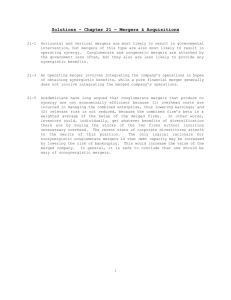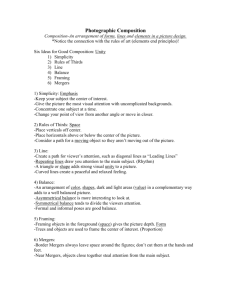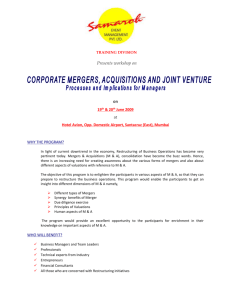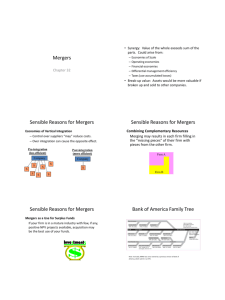Mergers & Acquisitions: Market Control, Tactics, and LBOs
advertisement
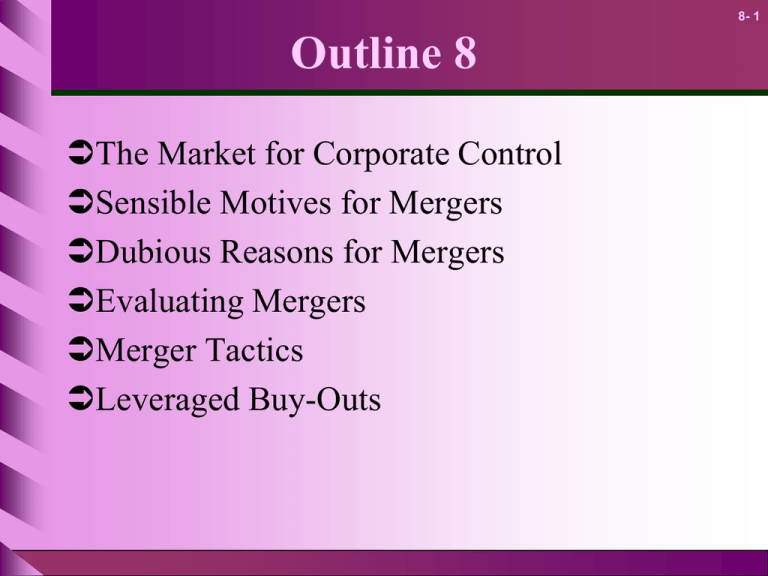
8- 1 Outline 8 The Market for Corporate Control Sensible Motives for Mergers Dubious Reasons for Mergers Evaluating Mergers Merger Tactics Leveraged Buy-Outs 8- 2 The Merger Market Methods to Change Management Proxy battle for control of the board of directors Firm purchased by another firm Leveraged buyout by a group of investors Divestiture of all or part of the firm’s business units 8- 3 Recent Mergers Acquiring Company American Online Chevron JDS Uniphase Deutsche Telecom BP Amoco (UK) Echostar Communications Hewlett-Packard American Intl. Group Phillips Petroleum Selling Company Time Warner Texaco SDL, Inc. VoiceStream Wireless Atlantic Richfield Hughes Electronics Compaq Computer American General Corp. Conoco Payment ($ billions) 106.0 42.9 41.1 29.4 27.2 25.8 25.0 24.6 24.2 8- 4 The Merger Market Tools Used To Acquire Companies Proxy Contest Tender Offer Acquisition Leveraged Buy-Out Merger Management Buy-Out 8- 5 Sensible Reasons for Mergers Economies of Scale A larger firm may be able to reduce its per unit cost by using excess capacity or spreading fixed costs across more units. Reduces costs $ $ $ 8- 6 Sensible Reasons for Mergers Economies of Vertical Integration Control over suppliers “may” reduce costs. Over integration can cause the opposite effect. 8- 7 Sensible Reasons for Mergers Combining Complementary Resources Merging may results in each firm filling in the “missing pieces” of their firm with pieces from the other firm. Firm A Firm B 8- 8 Sensible Reasons for Mergers Mergers as a Use for Surplus Funds If your firm is in a mature industry with few, if any, positive NPV projects available, acquisition may be the best use of your funds. 8- 9 Dubious Reasons for Mergers Diversification Investors should not pay a premium for diversification since they can do it themselves. 8- 10 Dubious Reasons for Mergers The Bootstrap Game Acquiring Firm has high P/E ratio Selling firm has low P/E ratio (due to low number of shares) After merger, acquiring firm has short term EPS rise Long term, acquirer will have slower than normal EPS growth due to share dilution. 8- 11 Evaluating Mergers Questions Is there an overall economic gain to the merger? Do the terms of the merger make the company and its shareholders better off? ???? PV(AB) > PV(A) + PV(B) 8- 12 Evaluating Mergers Economic Gain Economic Gain = PV(increased earnings) = New cash flows from synergies discount rate 8- 13 Evaluating Mergers Example - Given a 20% cost of funds, what is the economic gain, if any, of the merger listed below? Cislunar Foods Targetco Combined Company Revenues Operating Costs Earnings 150 118 32 20 16 4 172 132 40 4 Economic Gain = = $20 .20 (+2) (-2) (+4) 8- 14 Evaluating Mergers Estimated net gain Estimated net gain = DCF valuation of target including synergies - cash required for acquisition 8- 15 Merger Tactics White Knight - Friendly potential acquirer sought by a target company threatened by an unwelcome suitor. Shark Repellent - Amendments to a company charter made to forestall takeover attempts. Poison Pill - Measure taken by a target firm to avoid acquisition; for example, the right for existing shareholders to buy additional shares at an attractive price if a bidder acquires a large holding. 8- 16 Leveraged Buy-Outs Unique Features of LBOs Large portion of buy-out financed by debt Shares of the LBO no longer trade on the open market



